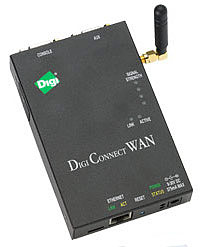Device-to-device communications takes off
Last updated Nov 19, 2008 — 870 views The machine-to-machine (“M2M”) communications market will grow robustly over the next five years, with an estimated 95 million cellular M2M modules shipping in 2013, ABI Research predicts.
The machine-to-machine (“M2M”) communications market will grow robustly over the next five years, with an estimated 95 million cellular M2M modules shipping in 2013, ABI Research predicts.
The key markets for M2M communications over this timeframe will continue to be telemetry, telematics, and wireless local loop, adds the market analyst firm.
Of 2013’s predicted 95 million M2M module shipments, ABI expects about 39 million to be consumed by telemetry applications, and another 39 million to go into telematics subsystems. [Some of Motorola’s current M2M module products can be seen here; Mot’s G24-Edge is pictured above.]
According to ABI senior analyst Sam Lucero, “Until about 2011, the major market growth will be found in the telemetry segment, since it encompasses a broad range of applications including smart metering, POS terminals, and remote monitoring and control applications.”
“After 2011, we expect to see a spike in telematics applications,” adds Lucero. “These exist now, but from 2011 will be driven more quickly by mandates such as Europe’s eCall initiative, which will see cellular connections in every vehicle, and in North America by a much stronger competitive reaction to OnStar: virtually of the major automakers will come out with OEM telematics programs. Commercial telematics [applications are] also set for strong growth as fleet managers use telematics to reduce fuel costs and increase overall operational efficiency.”
ABI expects average selling prices to decline across all air interface standards through about 2010, after which they should level out.
Will current global financial and economic uncertainties negatively affect this market? There is no immediate indication of this, although, notes Lucero, “A few companies have told ABI Research that the economic uncertainty will have a direct impact; we’re in the process of surveying selected industry stakeholders to evaluate whether our forecasts will need to be refined.”
 However one immediate pain-point in the market is the ability to develop applications easily and cost-effectively, ABI adds. Module makers such as Wavecom are involved, as are standalone software vendors such as Sensor Logic and equipment players such as Digi International. It’s not clear yet whether application developers will settle on one or another preferred type of ecosystem partner. [Digi Connect WAN module is pictured at right.]
However one immediate pain-point in the market is the ability to develop applications easily and cost-effectively, ABI adds. Module makers such as Wavecom are involved, as are standalone software vendors such as Sensor Logic and equipment players such as Digi International. It’s not clear yet whether application developers will settle on one or another preferred type of ecosystem partner. [Digi Connect WAN module is pictured at right.]
ABI Research’s recently-released “Cellular M2M Markets” study discusses these market forces, analyzes cellular M2M module vendor strategic responses, provides 2006/2007 vendor market share data, and forecasts cellular M2M module growth from 2008 through 2013. It’s part of three related ABI Research Services: M2M, Consumer Mobility, and Mobile Devices.


[This research brief is copyright © 2008 ABI Research. All rights reserved. Reproduced by DeviceGuru.com with permission.]


Any day device to device comm. is certainly better and more efficient then device to human or human to device comm. I hope it will encompass a broader perspective.